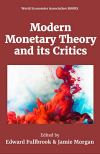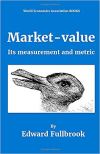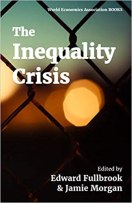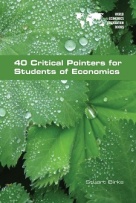Do economic models actually explain anything?
from Lars Syll
One of the limitations with economics is the restricted possibility to perform experiments, forcing it to mainly rely on observational studies for knowledge of real-world economies.
But still — the idea of performing laboratory experiments holds a firm grip of our wish to discover (causal) relationships between economic ‘variables.’  If we only could isolate and manipulate variables in controlled environments, we would probably find ourselves in a situation where we with greater ‘rigour’ and ‘precision’ could describe, predict, or explain economic happenings in terms of ‘structural’ causes, ‘parameter’ values of relevant variables, and economic ‘laws.’
If we only could isolate and manipulate variables in controlled environments, we would probably find ourselves in a situation where we with greater ‘rigour’ and ‘precision’ could describe, predict, or explain economic happenings in terms of ‘structural’ causes, ‘parameter’ values of relevant variables, and economic ‘laws.’
Galileo Galilei’s experiments are often held as exemplary for how to perform experiments to learn something about the real world.
Galileo’s heavy balls dropping from the tower of Pisa, confirmed that the distance an object falls is proportional to the square of time and that this law (empirical regularity) of falling bodies could be applicable outside a vacuum tube when e. g. air existence is negligible.
The big problem is to decide or find out exactly for which objects air resistance (and other potentially ‘confounding’ factors) is ‘negligible.’ In the case of heavy balls, air resistance is obviously negligible, but how about feathers or plastic bags?
One possibility is to take the all-encompassing-theory road and find out all about possible disturbing/confounding factors — not only air resistance — influencing the fall and build that into one great model delivering accurate predictions on what happens when the object that falls is not only a heavy ball but feathers and plastic bags. This usually amounts to ultimately state some kind of ceteris paribus interpretation of the ‘law.’
Another road to take would be to concentrate on the negligibility assumption and to specify the domain of applicability to be only heavy compact bodies. The price you have to pay for this is that (1) ‘negligibility’ may be hard to establish in open real-world systems, (2) the generalisation you can make from ‘sample’ to ‘population’ is heavily restricted, and (3) you actually have to use some ‘shoe leather’ and empirically try to find out how large is the ‘reach’ of the ‘law.’
In mainstream economics, one has usually settled for the ‘theoretical’ road (and in case you think the present ‘natural experiments’ hype has changed anything, remember that to mimic real experiments, exceedingly stringent special conditions have to obtain).
In the end, it all boils down to one question — are there any Galilean ‘heavy balls’ to be found in economics, so that we can indisputably establish the existence of economic laws operating in real-world economies?
As far as I can see there some heavy balls out there, but not even one single real economic law.
Economic factors/variables are more like feathers than heavy balls — non-negligible factors (like air resistance and chaotic turbulence) are hard to rule out as having no influence on the object studied.
Galilean experiments are hard to carry out in economics, and the theoretical ‘analogue’ models economists construct and in which they perform their ‘thought-experiments’ build on assumptions that are far away from the kind of idealized conditions under which Galileo performed his experiments. The ‘nomological machines’ that Galileo and other scientists have been able to construct have no real analogues in economics. The stability, autonomy, modularity, and interventional invariance, that we may find between entities in nature, simply are not there in real-world economies. That’s are real-world fact, and contrary to the beliefs of most mainstream economists, they won’t go away simply by applying deductive-axiomatic economic theory with tons of more or less unsubstantiated assumptions.
By this, I do not mean to say that we have to discard all (causal) theories/laws building on modularity, stability, invariance, etc. But we have to acknowledge the fact that outside the systems that possibly fulfil these requirements/assumptions, they are of little substantial value. Running paper and pen experiments on artificial ‘analogue’ model economies is a sure way of ‘establishing’ (causal) economic laws or solving intricate econometric problems of autonomy, identification, invariance and structural stability — in the model world. But they are pure substitutes for the real thing and they don’t have much bearing on what goes on in real-world open social systems. Setting up convenient circumstances for conducting Galilean experiments may tell us a lot about what happens under those kinds of circumstances. But — few, if any, real-world social systems are ‘convenient.’ So most of those systems, theories and models, are irrelevant for letting us know what we really want to know.
To solve, understand, or explain real-world problems you actually have to know something about them — logic, pure mathematics, data simulations or deductive axiomatics don’t take you very far. Most econometrics and economic theories/models are splendid logic machines. But — applying them to the real world is a more or less hopeless undertaking! The assumptions one has to make in order to successfully apply these deductive-axiomatic theories/models/machines are devastatingly restrictive and mostly empirically untestable– and hence make their real-world scope ridiculously narrow. To fruitfully analyse real-world phenomena with models and theories you cannot build on patently and known to be ridiculously absurd assumptions. No matter how much you would like the world to entirely consist of heavy balls, the world is not like that. The world also has its fair share of feathers and plastic bags.
The problem is that most of the ‘idealizations’ we find in mainstream economic models are not ‘core’ assumptions, but rather structural ‘auxiliary’ assumptions. Without those supplementary assumptions, the core assumptions deliver next to nothing of interest. So to come up with interesting conclusions you have to rely heavily on those other — ‘structural’ — assumptions.
The auxiliary assumptions matter crucially. So, what’s the problem? There is standardly no way the results we get in the mainstream models would happen in reality! Not even extreme idealizations in the form of invoking non-existent entities such as ‘actors maximizing expected utility,’ ‘rational expectations’ or ‘representative agents’ deliver. The models simply are not Galilean thought-experiments. Given the set of constraining assumptions, this happens. But change only one of these assumptions and something completely different may happen.
The lack of ‘robustness’ with respect to variation of the model assumptions underscores that this is not the kind of knowledge we are looking for. We want to know what happens to unemployment in general in the real world, not what might possibly happen in a model given a constraining set of known to be false assumptions. This should come as no surprise. How that model with all its more or less outlandishly looking assumptions ever should be able to connect with the real world is, to say the least, somewhat unclear. The total absence of strong empirical evidence and the lack of similarity between the heavily constrained model and the real world makes it even more difficult to see how there could ever be any inductive bridging between them. The assumptions are not only unrealistic. They are unrealistic in the wrong way.
Mainstream ‘as if’ models are based on the logic of idealization and a set of tight axiomatic and ‘structural’ assumptions from which consistent and precise inferences are made. The beauty of this procedure is, of course, that if the assumptions are true, the conclusions necessarily follow. But it is a poor guide for real-world systems.
Showing that something is possible in a ‘possible world’ doesn’t give us a justified license to infer that it therefore also is possible in the real world. ‘The Great Gatsby’ is a wonderful novel, but if you truly want to learn about what is going on in the world of finance, I would recommend rather reading Minsky or Keynes and directly confront real-world finance.
The assumptions and descriptions we use in our modelling have to be true — or at least ‘harmlessly’ false — and give a sufficiently detailed characterization of the mechanisms and forces at work. Models in mainstream economics do nothing of the kind.
Our aspirations have to be more far-reaching than just constructing coherent and ‘credible’ models about ‘possible worlds’. We want to understand and explain ‘difference-making’ in the real world and not just in some made-up fantasy world. Science has to be something more than just more or less realistic ‘story-telling’ or ‘explanatory fictionalism’. You have to provide decisive empirical evidence that what you can infer in your model also helps us to uncover what actually goes on in the real world. If you fail to support your models in that way, you come up with nothing that holds as an explanation what goes on in the world in which we live.
Telling us that something is possible in a possible or ‘credible’ world is not enough. Showing us that something possibly can happen in a model world, is not enough to explain what actually happens in the real world.
































Guaranteed monetary security, the heavy ball of economics.
Neither can the geological sciences perform ‘experiments’. The Earth is much messier than a physics lab too, though not as messy as social systems. This has not prevented a great deal of progress in understanding how the Earth works.
See my several discussions of how science really works, including in the book now listed in the right-hand column: Economy, Society, Nature
What do you think of this Geoff?
https://www.tandfonline.com/doi/pdf/10.1080/14747731.2019.1669915?needAccess=true
>>Our aspirations have to be more far-reaching than just constructing coherent and ‘credible’ models about ‘possible worlds’. We want to understand and explain ‘difference-making’ in the real world and not just in some made-up fantasy world. Science has to be something more than just more or less realistic ‘story-telling’ or ‘explanatory fictionalism’. You have to provide decisive empirical evidence that what you can infer in your model also helps us to uncover what actually goes on in the real world. If you fail to support your models in that way, you come up with nothing that holds as an explanation what goes on in the world in which we live.
Lars Syll uttered something positive and normative at last. This is your image of economics as a science. That is all right. Then, what do you do in order to create a new economics that will satisfy at least some of your criteria?
Syll’s last paragraph:
>> Telling us that something is possible in a possible or ‘credible’ world is not enough. Showing us that something possibly can happen in a model world, is not enough to explain what actually happens in the real world.
Instead of it, I would say to Lars Syll:
Telling us that this or that theory is impossible in a real world is not enough. (This is what Lars Syll is doing). Show us even a very small step forward in which we can begin to understand what actually happens in the real world. (No hints?)
Parentheses are my comments.
For a model to be useful it either has to be derived from first principles or based on valid abstract theory. If based on anything else it will be incapable of providing any useful information. Engineers have made use of both physical and mathematical models with great success.
Economists, both orthodox and heterodox, achieve neither of the above conditions. All their
analyses in which models are presented are based on guessing valid relationships and then “calibrating” with some data set. “Calibrating” means fitting equations to the data and then because the calibrated relationship matches the data they claim their model is valid. Any arbitrary equation can be fitted to the same data, possibly with greater precision, but one would not claim any theoretical validity for it.
As I keep pointing out, there is not one orthodox or heterodox quantitative relationship which meets the requirements for theoretical validity. I would appreciate some comments as to whether any of you accept this scientific truth. Clearly Lars Syll fails to understand this. If he did, he would be attempting to take “some small step” as requested by Yoshinori Shiozawa.
Perhaps sides are talking at cross purposes here?
Is all insight “information” in a strict symbolically expressible model sense – must all insight regarding social and economic processes be of this kind?
Lars, up to these sentences, I’m with you. “So most of those systems, theories and models, are irrelevant for letting us know what we really want to know.” “To solve, understand, or explain real-world problems you actually have to know something about them — logic, pure mathematics, data simulations or deductive axiomatics don’t take you very far.” I agree, but Lars the alternatives you offer take us nowhere, either. Thousands of different data points can be recorded on any so called “real-world” problem. And countless theories can be formulated to “explain” all or any subset of these data points. The problem you offer, unemployment is certainly such a problem. What data do we collect on unemployment? This leads to a definition for us to follow in collating that data and deciding on how we choose to theorize about it. This is an infinite process, since we can always choose other data points and apply other theories. Given sufficient time and work ethic we could possibly consider all data and theories we believe interesting. If we search long enough and hard enough perhaps, we could even choose to call one set of data points and one theory applied to them “the truth.” But that is a choice we make, not a universal pattern we can ever confirm. The ending of your piece concludes, therefore with a massive mistake. “Our aspirations have to be more far-reaching than just constructing coherent and ‘credible’ models about ‘possible worlds’. We want to understand and explain ‘difference-making’ in the real world and not just in some made-up fantasy world. Science has to be something more than just more or less realistic ‘story-telling’ or ‘explanatory fictionalism’. You have to provide decisive empirical evidence that what you can infer in your model also helps us to uncover what actually goes on in the real world. If you fail to support your models in that way, you come up with nothing that holds as an explanation what goes on in the world in which we live.” Much as this may disturb you, the focus of science is constructing plausible and articulate scenarios about possible worlds. That we can use to explore and from which we can learn, to build on. Science is thus storytelling, about these possible worlds. As to “decisive empirical evidence,” that’s never accessible. Our best effort is always the data we choose to record and the theories we choose to apply to this data. And since science is just a reflection of humans’ everyday life actions, choosing data and theories is what humans have done since evolving on the planet.
If you deal with social science why do you turn to the physical world for your scientific priniples and methods. Deal with the people who every day in specific places and times have to deal with economic problems. Ask them what they learn from economics that helps them solve their problems. People on this blog turn to physical science to find comparisons for economic process, and they quote endlessly the work of economists, often inspired by physical science (Newton) achievements. It doesn’t work as a procedure for understanding economic process specific to time or place.
For example, when trying to explain Germany’s preeminence in the high tech industries in the late 19th century, I did so just when the New Economic History methods invaded economic and business history. They proved that my problem, did not exist, despite the fact that engineers, politicians, educators, business leaders, etc. living in the late 19th century were saying this problem existed and that they explain why in work about the relative backwardness of French high tech industry (a theme that persists to this day) and the stagnation of the British high tech economy. If you could not find this stagnation in neoclassical theory or in econometrics, when people of the time themselves wrote a lot about it, especiallly with respect to the mental capital necessary for an economy to stay ahead in innovative technologies, then you are a fool to use neoclassical and econometrics to explain economic process in the 2nd industrial revolution.